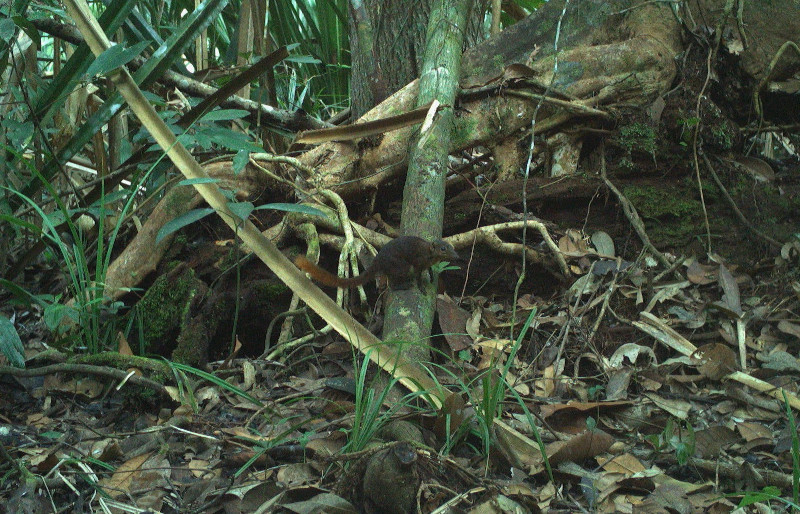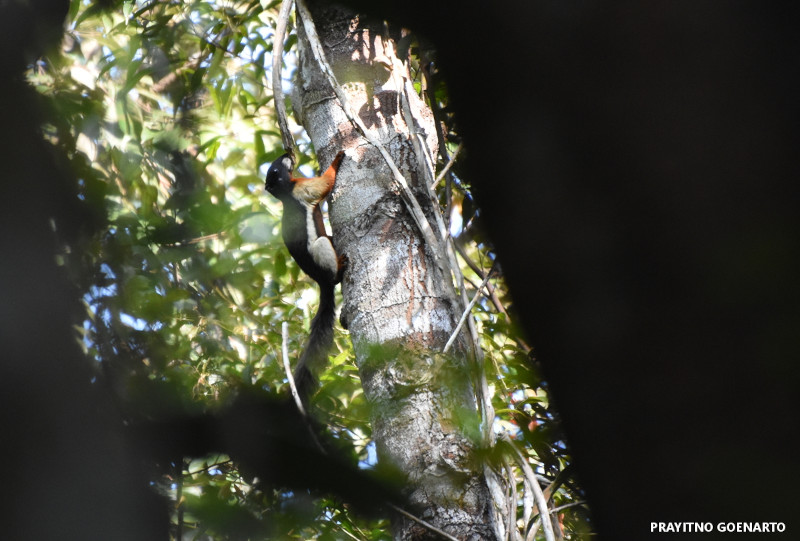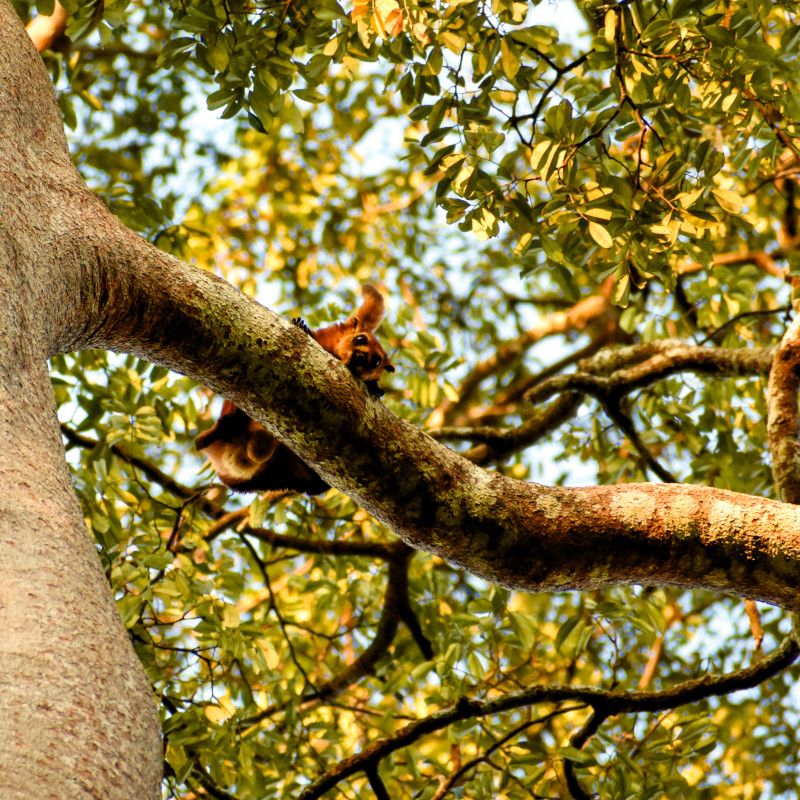September 09, 2025
When walking through the forests of Restorasi Ekosistem Riau (RER), researchers often spot movement in the treetops or on the forest floor. Their binoculars and telephoto lenses sometimes land on two of the region’s most elusive but charismatic species: tree shrews (tupai) and squirrels (bajing).
They may be small, but both these animals play a big part in their ecosystem, and even contribute to forest restoration. In this article, we’ll reveal the intricate and sometimes surprising roles they play, along with their biology, behavior, and ecology.
Family Matters: Taxonomy & Classification
Tree shrews belong to the order Scandentia, whereas squirrels belong to the order Rodentia, in the Sciuridae family. Squirrels are true rodents, closely related to mice, rats, and beavers. Tree shrews, on the other hand, are more closely related to primates than rodents.
Recent studies have revealed that tree shrews actually share several neurological and sensory traits with early primates, making them an important case study in evolutionary biology research.

From Tooth to Tail: Anatomy & Physical Traits
Tree shrews have a slender body with short limbs and a long, pointed snout. Their tails are often bushy, but not significantly more than in the case of squirrels. Their small, sharp teeth are ideally adapted for eating insects and fruit.
Squirrels, by comparison, have a compact body with strong hind legs and a short snout. Their main distinguishing feature is a distinctive bushy tail, which they use for balance and communication. Squirrels also have strong incisors, which they have evolved for gnawing nuts and bark.
A remarkable fact about tree shrews is that they have one of the highest brain-to-body mass ratios of all mammals, putting them on a par with primates. This has made them valuable in neurological and behavioral studies, including research on vision, memory, and stress responses.
From Canopy to Forest Floor: Habitat & Ecology
Tree shrews are mostly diurnal and terrestrial or semi-arboreal. They can be found in lowland and hill forests throughout Southern and Southeast Asia, from Northeast India and Southern China down to Myanmar, Thailand, Malaysia, Indonesia, and the Philippines. Here, they are often seen on the forest floor or in areas of low vegetation, foraging for food.
Squirrels are typically arboreal and spend their time in the tree canopies, where they build nests (known as ‘dreys’) in trees. With most of their life spent up in the canopy, they are very nimble, agile climbers and can often be seen leaping from branch to branch. These death-defying acrobatics enable them to evade predators, while also playing a part in their courtship rituals.
Unlike many small mammals, tree shrews are diurnal and often forage on or near the forest floor. This contrasts with squirrels, which are mostly arboreal. Together, the two groups fill separate ecological niches in tropical forests like RER.

Diet & Behavior
Tree shrews are omnivores, with a diet that consists of insects, fruit, small vertebrates, and sometimes nectar. Squirrels, on the other hand, are primarily herbivorous; their diet is made up of fruits, seeds, nuts, and bark.
In addition to the food they eat, tree shrews and squirrels can be distinguished by how they act. For example, tree shrews are usually solitary and territorial. These fast-moving and elusive creatures use scent marking to communicate with other tree shrews in their habitat; they use scent glands on the chest and genitals to mark their territories and pathways through the forest.
Interestingly, some tree shrew species exhibit a rare mammalian behavior called ‘absentee maternal care’, whereby mothers leave their young alone for extended periods, returning only to nurse briefly every other day or so.
Conversely, some species of squirrel are known for being acutely social creatures (although some others are solitary). Most are also known for their habit of storing (or ‘squirreling’) away food.
Ecosystem Services and Forest Regeneration Roles
Tree shrews help control insect populations and disperse the seeds of fruiting plants. They consume a high volume of insects such as beetles, ants, and termites, which helps to regulate populations of forest-floor and understory invertebrates. Squirrels too act as important seed dispersal agents in their ecosystem, while their habit of nut caching also plays a subtle but important role in forest regeneration.
In fact, squirrels are a true friend of the forest – throughout the year, they scatter-hoard nuts and seeds, burying them in hundreds of small caches to retrieve later. But they don’t recover them all. Recent estimates suggest squirrels fail to retrieve almost three quarters of their cached nuts; many of these forgotten seeds then germinate and grow into trees.
Studies in North America have found that up to 30 percent of new oak trees in some forests originated from seeds cached by squirrels. Similar scatter-hoarding behavior by squirrels in tropical Asia, including the plantain squirrel (Callosciurus notatus), helps regenerate forest species like nutmeg, durian, and dipterocarps.
Because squirrels scatter their caches across wide areas, they increase the spatial spread and survival chances of seeds, especially for large-seeded tropical trees that can’t disperse far on their own. This makes them a valuable ally in the fight to expand and restore forest areas like RER.

From Root to Branch: Conservation in the RER Forest
The latest RER biodiversity surveys on the Kampar Peninsula and Padang Island, completed in July 2024, revealed the staggering health and diversity of the ecosystem. A total of 901 species were recorded, including 78 mammals, 106 amphibians and reptiles, 319 birds, 207 plant species, 89 fish and 102 odonates (dragonflies & damselflies).
None of these species exist in isolation. Together, they form an interconnected web of life, in which even the smallest creatures play a crucial role in their ecosystem and contribute to the overall health of the forest. Tree shrews and squirrels may appear small and inconsequential, but they make an invaluable contribution to this community of forest dwellers.
Both help regulate insect populations, disperse seeds, and maintain healthy forest-floor dynamics – vital functions in restoration zones. Together, they illustrate the temporal and ecological diversity of restored peat swamp ecosystems like RER in Indonesia.
For those who work and study here, the sight of these small and charismatic mammals, whether in the treetops or on the forest floor, is a clear sign of ecosystem health. Moreover, squirrels and tree shrews offer a reminder that, whenever you look closer into the biodiversity of RER, there’s always another layer of understanding and something new to explore.